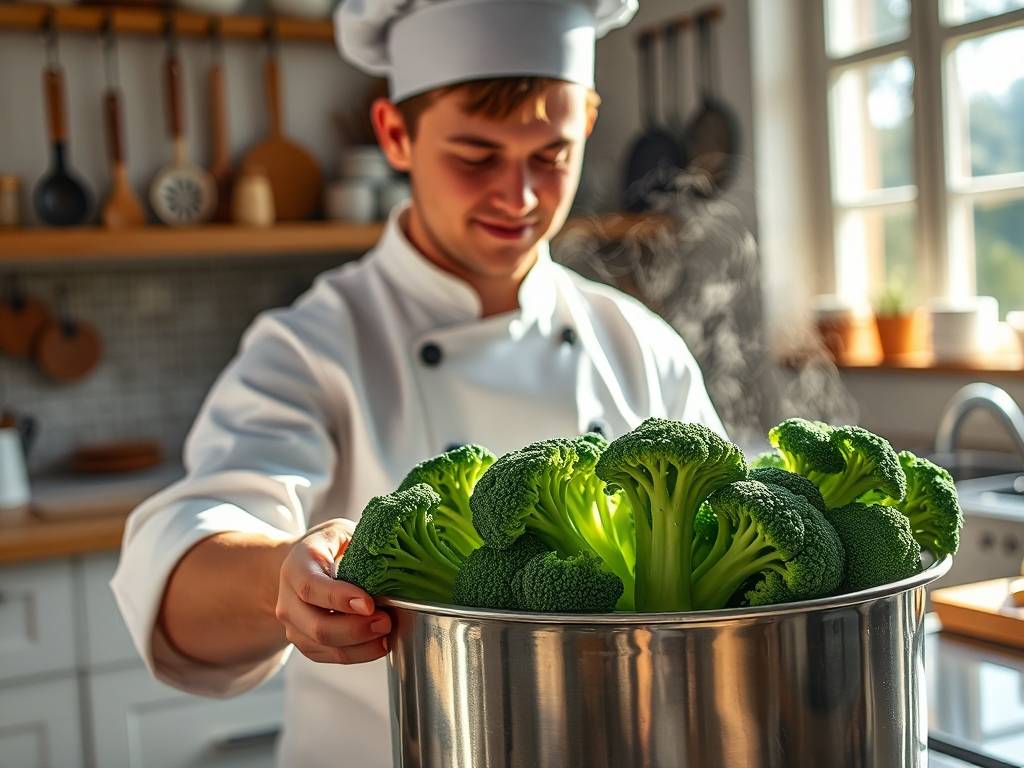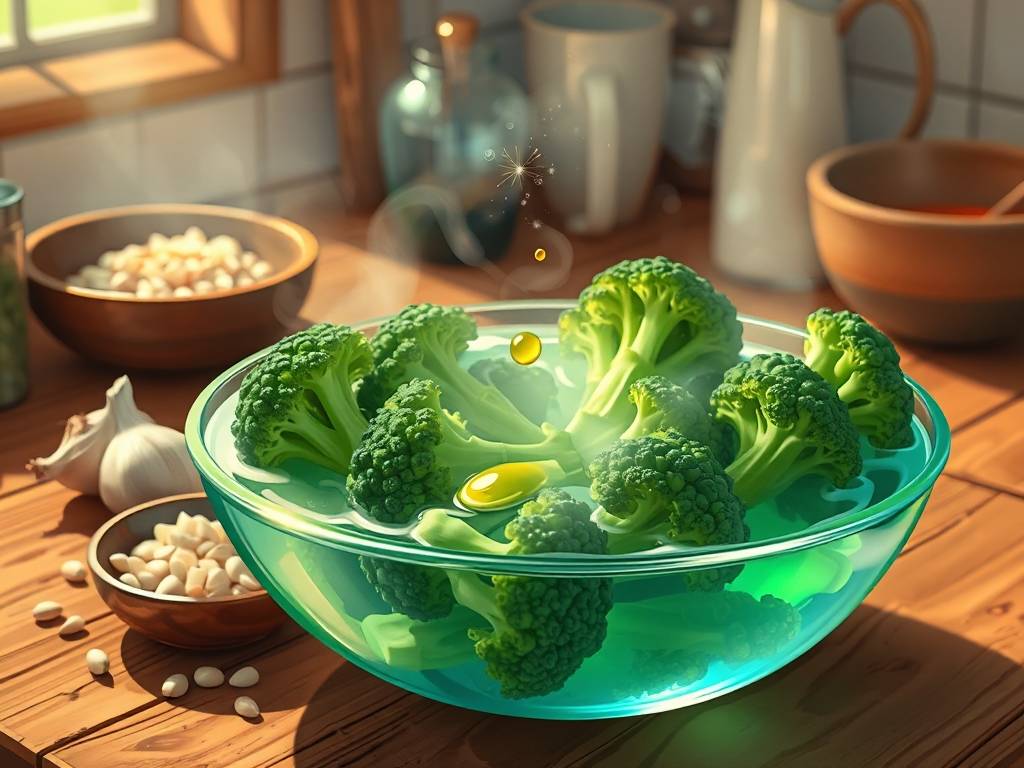The Secret to Perfect Garlic Broccoli: One Drop of Oil and a World of Flavor
Garlic broccoli is a staple in many households, a dish that seems simple yet often falls short of its potential. Many home cooks struggle with achieving that vibrant green color, rich garlic flavor, and nutrient-packed bite that makes restaurant-style broccoli so irresistible. The common pitfalls are many: overcooking leads to a mushy texture, undercooking results in a tough and bitter taste, and improper preparation can cause the loss of valuable nutrients. But what if there was one simple secret that could transform this humble vegetable into a culinary masterpiece? The answer lies in a technique so subtle yet so powerful that it might just change the way you cook vegetables forever: adding a single drop of oil during the blanching process.
The Science Behind Blanching

To understand why this method works so well, we must first delve into the science of blanching. Blanching is a cooking process that involves briefly submerging food in boiling water, then immediately transferring it to an ice bath to halt the cooking. This technique is particularly popular with green vegetables like broccoli because it helps preserve color, texture, and nutritional value.
When broccoli is exposed to heat, its cells begin to break down. Chlorophyll, the pigment responsible for its green color, is sensitive to heat and acidity. Without proper handling, it can easily turn into pheophytin, resulting in a dull, olive-green appearance. Additionally, water-soluble nutrients like vitamin C and B vitamins can leach out into the cooking water if the vegetable is boiled for too long.
The traditional advice for blanching broccoli often involves using a large pot of generously salted boiling water. While this method works reasonably well, it doesn’t always guarantee that bright green color or prevent some nutrient loss. This is where the one-drop oil technique comes into play.
The Magic of One Drop of Oil
Adding a single drop of a neutral oil, such as vegetable or canola oil, to the blanching water might seem inconsequential, but it has a profound impact. Oil and water don’t mix, so the oil forms a microscopic layer on the surface of the water. When broccoli is added to the pot, this oily layer coats the vegetable as it is submerged, creating a delicate barrier between the broccoli and the water.
This barrier serves multiple purposes. First, it minimizes the direct contact between the broccoli and the water, reducing the leaching of water-soluble nutrients. Studies have shown that vegetables blanched with a small amount of oil retain more vitamins and minerals compared to those blanched in plain water. Second, the oil helps seal in the chlorophyll, protecting it from prolonged exposure to heat and oxygen, which are the primary culprits behind color degradation. The result is broccoli that emerges from the blanching process with a stunning, bright green hue that looks as good as it tastes.

Moreover, the oil coating ensures that the broccoli remains slightly glossy after cooking, enhancing its visual appeal. This technique is particularly useful when preparing broccoli for salads, stir-fries, or as a side dish where appearance matters just as much as flavor.
Mastering the Garlic Flavor
Of course, the other half of the equation is the garlic. Broccoli and garlic are a match made in culinary heaven, but achieving that perfect garlicky flavor without overpowering the dish or burning the garlic requires finesse. The key is to add garlic at the right stage of cooking.
After blanching the broccoli, it’s essential to pat it dry thoroughly. Any excess moisture can cause oil to splatter during the sautéing process and dilute the garlic flavor. Heat a tablespoon of oil in a pan over medium heat—too high, and the garlic will burn and turn bitter. Add finely minced or sliced garlic and sauté for just 30 seconds to a minute until it becomes fragrant. The goal is to toast the garlic lightly, unlocking its aromatic compounds without browning it too much.
Then, add the blanched broccoli to the pan. Toss it gently to coat it evenly with the garlic-infused oil. The blanching process has already partially cooked the broccoli, so it only needs a minute or two in the pan to heat through and absorb the garlic flavor. This two-step cooking process—blanching followed by a quick sauté—ensures that the broccoli remains crisp-tender and packed with garlic goodness.
Why This Method Preserves Nutrients
Nutrient loss is a significant concern when cooking vegetables. Broccoli is a nutritional powerhouse, rich in vitamin C, vitamin K, folate, and fiber, as well as antioxidants like sulforaphane. Unfortunately, many cooking methods can diminish these benefits. Boiling, for instance, can cause up to 50% of water-soluble vitamins to be lost in the cooking water.
Blanching, when done correctly, is one of the best ways to preserve nutrients. The brief cooking time minimizes exposure to heat, and the ice bath stops the enzymatic activity that can lead to nutrient degradation. Adding a drop of oil to the blanching water enhances this effect by creating a protective layer that reduces leaching. Additionally, because the broccoli is only sautéed for a short time after blanching, it doesn’t undergo further significant nutrient loss.
This method also helps preserve the integrity of heat-sensitive compounds like vitamin C and certain antioxidants. The result is a dish that is not only delicious but also as nutritious as possible.
Step-by-Step Guide to Perfect Garlic Broccoli
To achieve the perfect garlic broccoli at home, follow these steps:
- Prepare the Broccoli: Cut a head of broccoli into even-sized florets. This ensures that they cook uniformly.
- Blanch: Bring a large pot of water to a rolling boil. Add a generous pinch of salt and one drop of neutral oil. Add the broccoli and blanch for 60-90 seconds, depending on the size of the florets.
- Ice Bath: Immediately transfer the blanched broccoli to a bowl of ice water. Let it sit for a minute to stop the cooking process, then drain and pat dry thoroughly.
- Sauté the Garlic: Heat a tablespoon of oil in a pan over medium heat. Add minced garlic and sauté until fragrant, about 30 seconds.
- Combine: Add the blanched broccoli to the pan. Toss to coat with the garlic oil and season with salt, pepper, and a pinch of red pepper flakes if desired. Sauté for another 1-2 minutes until heated through.
- Serve: Transfer to a serving dish and enjoy immediately.
Variations and Tips
While the basic recipe is straightforward, there are endless ways to customize it. For added depth, try using garlic-infused oil instead of plain oil during the sautéing step. A squeeze of lemon juice at the end can brighten the flavors and add a touch of acidity. For a richer dish, sprinkle with grated Parmesan cheese or toasted almond slices.
If you prefer a saucier version, consider adding a splash of soy sauce or oyster sauce along with the garlic. This works particularly well for an Asian-inspired twist. Alternatively, a drizzle of chili oil can add heat and complexity.
When selecting broccoli, look for firm, dark green heads with tightly closed florets. Avoid any with yellowing or wilting, as this indicates age and reduced flavor.
Conclusion
The secret to perfect garlic broccoli—vibrant green color, rich garlic flavor, and minimal nutrient loss—is surprisingly simple. By adding just one drop of oil to the blanching water, you create a protective barrier that preserves the vegetable’s color and nutritional value. Paired with a quick sauté of garlic, this method transforms ordinary broccoli into an extraordinary dish that is both healthy and delicious.
Next time you’re in the kitchen, give this technique a try. It’s a small step with a big impact, proving that sometimes the simplest secrets are the most powerful.






发表评论